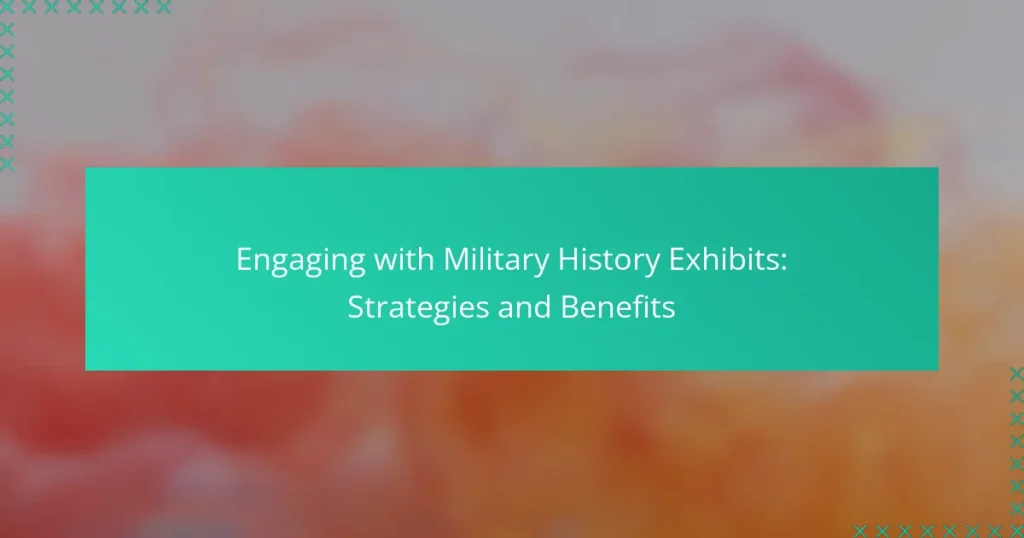Engaging with military history exhibits in major U.S. cities provides a unique opportunity to explore the complexities of warfare and its societal impacts. By employing strategies such as pre-visit research and utilizing interactive elements, visitors can enhance their understanding and appreciation of historical events. These exhibits not only educate but also foster community engagement and connection to the past.
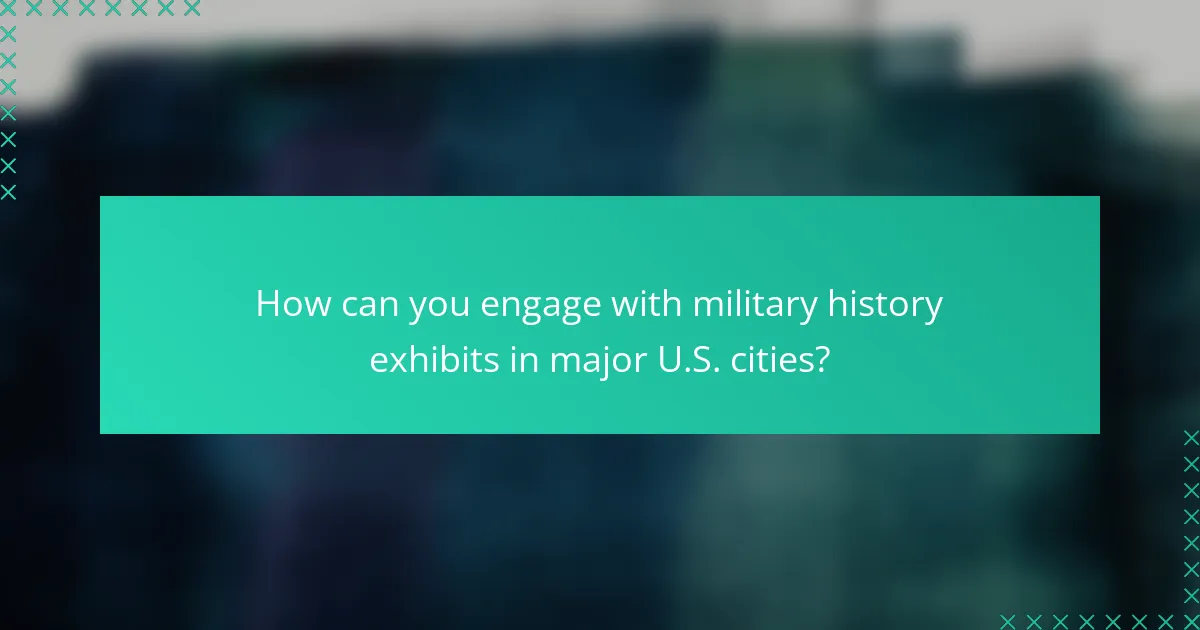
How can you engage with military history exhibits in major U.S. cities?
Engaging with military history exhibits in major U.S. cities can be both informative and immersive. By utilizing various interactive elements, guided tours, and educational programs, visitors can deepen their understanding of military history in an engaging way.
Interactive displays
Interactive displays allow visitors to engage directly with artifacts and information. These exhibits often include touchscreens, augmented reality, and multimedia presentations that enhance the learning experience. For example, a display might allow you to explore a battlefield through an interactive map or listen to firsthand accounts from veterans.
When visiting, look for exhibits that encourage participation, such as quizzes or simulations. These elements can make the experience more memorable and enjoyable.
Guided tours
Guided tours provide structured insights into military history exhibits, often led by knowledgeable guides. These tours can vary in length, typically lasting from one hour to several hours, depending on the exhibit’s size and complexity. A guide can offer context and stories that enrich the artifacts on display.
Consider joining a themed tour that focuses on specific events or eras, such as World War II or the Vietnam War. This can provide a more focused understanding of the subject matter.
Virtual reality experiences
Virtual reality (VR) experiences immerse visitors in historical scenarios, allowing them to “experience” events as if they were there. Many museums in major U.S. cities offer VR setups that recreate significant battles or military operations. These experiences can last anywhere from a few minutes to half an hour.
Before participating, check if reservations are needed, as VR experiences can have limited availability. This technology can be particularly engaging for younger audiences, making history come alive in a unique way.
Hands-on workshops
Hands-on workshops provide practical experiences related to military history, such as weapon handling, tactical training, or historical reenactments. These workshops typically last a few hours and can cater to various age groups and skill levels. Participants can gain a deeper appreciation for the skills and strategies used in historical contexts.
Look for workshops that offer a safe environment with trained instructors. Engaging in these activities can foster a greater understanding of the challenges faced by military personnel throughout history.
Educational programs
Educational programs often include lectures, seminars, and special events designed to deepen knowledge of military history. These programs may be targeted at students, educators, or the general public and can vary in duration from a single session to a multi-week course.
Check local museums or historical societies for upcoming programs that align with your interests. Participating in these programs can provide valuable insights and foster discussions with experts and fellow history enthusiasts.
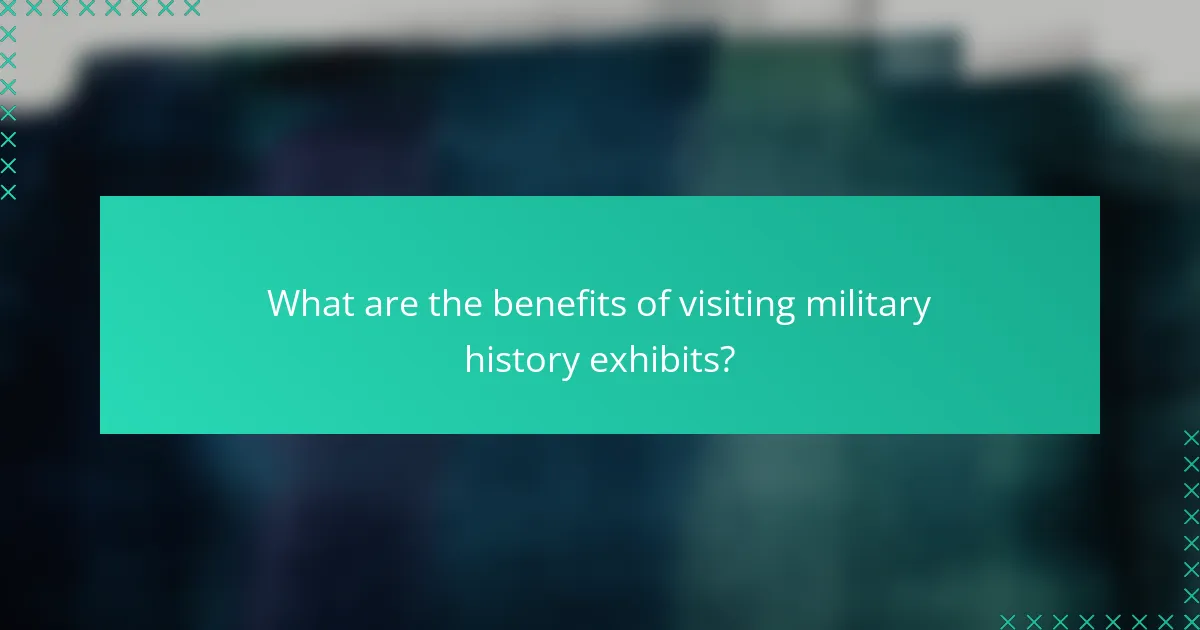
What are the benefits of visiting military history exhibits?
Visiting military history exhibits offers numerous benefits, including a deeper appreciation for historical events and the opportunity to engage with the community. These exhibits provide insights into military strategies, sacrifices, and the impact of warfare on society.
Enhanced historical understanding
Military history exhibits enhance historical understanding by presenting artifacts, documents, and narratives that bring past events to life. Visitors can explore the complexities of wars, including causes, key figures, and outcomes, which fosters a more nuanced perspective on history.
Engaging with these exhibits allows individuals to connect emotionally with history, making it more relatable and impactful. For example, seeing a soldier’s uniform or personal letters can create a tangible link to the past that textbooks often lack.
Community engagement
Military history exhibits often serve as community hubs, bringing together individuals with shared interests in history and heritage. These events can foster discussions, workshops, and lectures that encourage local participation and collaboration.
Participating in community events related to military history can strengthen local ties and promote a sense of belonging. Many museums host special events, such as reenactments or veteran talks, which can further enhance community engagement.
Support for local museums
Visiting military history exhibits supports local museums financially and operationally. Admission fees, donations, and memberships contribute to the maintenance and development of these cultural institutions.
By attending exhibits, visitors help ensure that museums can continue to provide educational resources and preserve historical artifacts for future generations. Supporting local museums also encourages them to host more events and expand their collections.
Networking opportunities
Military history exhibits provide valuable networking opportunities for individuals interested in history, education, or military service. Attendees can meet historians, educators, and fellow enthusiasts, fostering connections that may lead to collaborations or mentorships.
Engaging with others at these events can also open doors to volunteer opportunities or internships at museums, enhancing personal and professional growth within the field of history.

What strategies improve the experience at military history exhibits?
To enhance your experience at military history exhibits, consider strategies like pre-visit research, utilizing mobile apps, participating in special events, and engaging with experts. These approaches can deepen your understanding and make your visit more enjoyable and informative.
Pre-visit research
Conducting pre-visit research allows you to familiarize yourself with the exhibit’s themes, artifacts, and historical context. Look for information on the exhibit’s website, read articles, or watch documentaries related to the topics covered. This preparation can help you ask informed questions and appreciate the significance of the displays.
Additionally, check for any specific artifacts or stories that particularly interest you. Knowing what to look for can enhance your engagement and make your visit more meaningful.
Utilizing mobile apps
Many military history exhibits offer mobile apps that provide interactive content, audio guides, and augmented reality features. Downloading these apps before your visit can enhance your experience by providing additional context and information about the exhibits. Look for features like maps, schedules, and notifications about special presentations.
Using mobile apps can also help you navigate the exhibit more efficiently, ensuring you don’t miss key displays or events. Be sure to check if the app includes user reviews or tips from previous visitors for added insights.
Participating in special events
Exhibits often host special events such as lectures, guided tours, or reenactments. Participating in these activities can provide a deeper understanding of military history and allow you to engage with the material in a dynamic way. Check the exhibit’s calendar for upcoming events during your visit.
Special events may also feature guest speakers, including historians or veterans, who can share personal stories and insights. These interactions can enrich your experience and provide unique perspectives on the historical narratives presented.
Engaging with experts
Take advantage of opportunities to engage with historians, curators, or docents during your visit. Asking questions and discussing specific artifacts can enhance your understanding and appreciation of the exhibit. Experts can provide context that may not be available through written materials or audio guides.
Consider attending Q&A sessions or panel discussions if offered. Engaging directly with knowledgeable individuals can deepen your insight into military history and foster a more interactive experience.
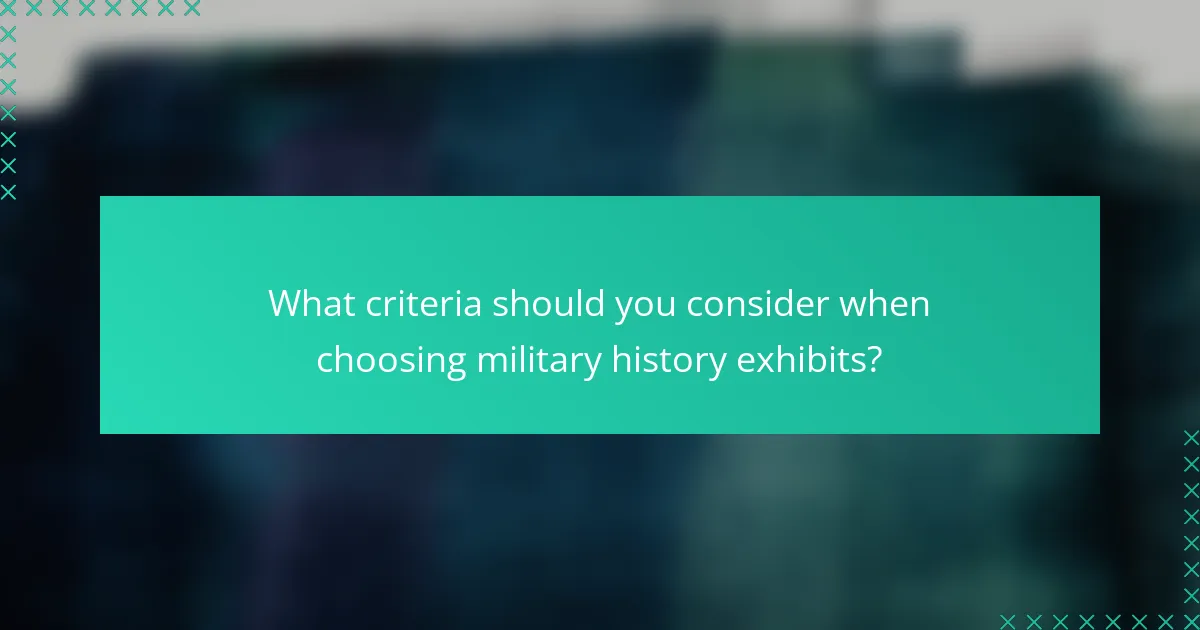
What criteria should you consider when choosing military history exhibits?
When selecting military history exhibits, consider factors such as accessibility, thematic relevance, and visitor feedback. These criteria will help ensure a meaningful and engaging experience tailored to your interests and needs.
Location accessibility
Location accessibility refers to how easy it is to reach the exhibit. Check if the venue is well-connected by public transport or if parking is available. For instance, urban museums often have better access than rural sites.
Additionally, consider the physical accessibility of the exhibit itself. Look for features such as wheelchair ramps, elevators, and guided tours for individuals with mobility challenges. Many venues provide this information on their websites.
Exhibit themes
Exhibit themes can vary widely, from specific battles and military technology to broader topics like the impact of war on society. Identifying your interests can help narrow down your choices. For example, if you are fascinated by World War II, seek out exhibits that focus on that era.
Some exhibits may also feature interactive elements or multimedia presentations, enhancing the learning experience. Research the themes beforehand to ensure they align with your interests and educational goals.
Visitor reviews
Visitor reviews provide valuable insights into the quality and engagement level of military history exhibits. Look for feedback on platforms like TripAdvisor or Google Reviews to gauge overall satisfaction and highlight any standout features.
Pay attention to comments regarding the exhibit’s educational value, organization, and staff knowledge. This information can help you avoid potential disappointments and select exhibits that have received positive feedback from previous attendees.
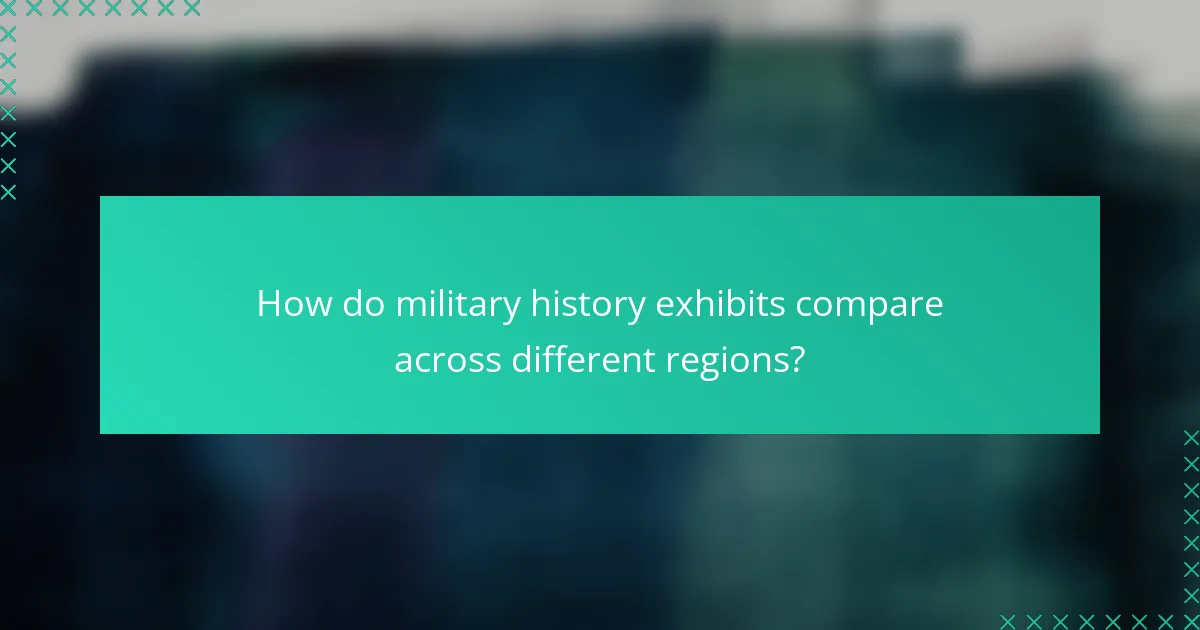
How do military history exhibits compare across different regions?
Military history exhibits vary significantly across regions, influenced by local culture, historical events, and available resources. In some areas, exhibits may focus on specific conflicts or military branches, while others offer a broader perspective on global military history.
Exhibit diversity in Washington, D.C.
Washington, D.C. is home to a rich array of military history exhibits, reflecting the nation’s diverse military heritage. The National Museum of American History and the National World War II Memorial are prime examples, showcasing artifacts, personal stories, and interactive displays that engage visitors.
Exhibits in D.C. often emphasize the significance of key battles and the experiences of soldiers from various backgrounds. Visitors can explore topics ranging from the Revolutionary War to contemporary conflicts, providing a comprehensive understanding of the U.S. military’s evolution.
When visiting, consider allocating several hours to fully appreciate the depth of these exhibits. Engaging with guided tours or educational programs can enhance the experience, offering insights that may not be immediately apparent from the displays alone.
